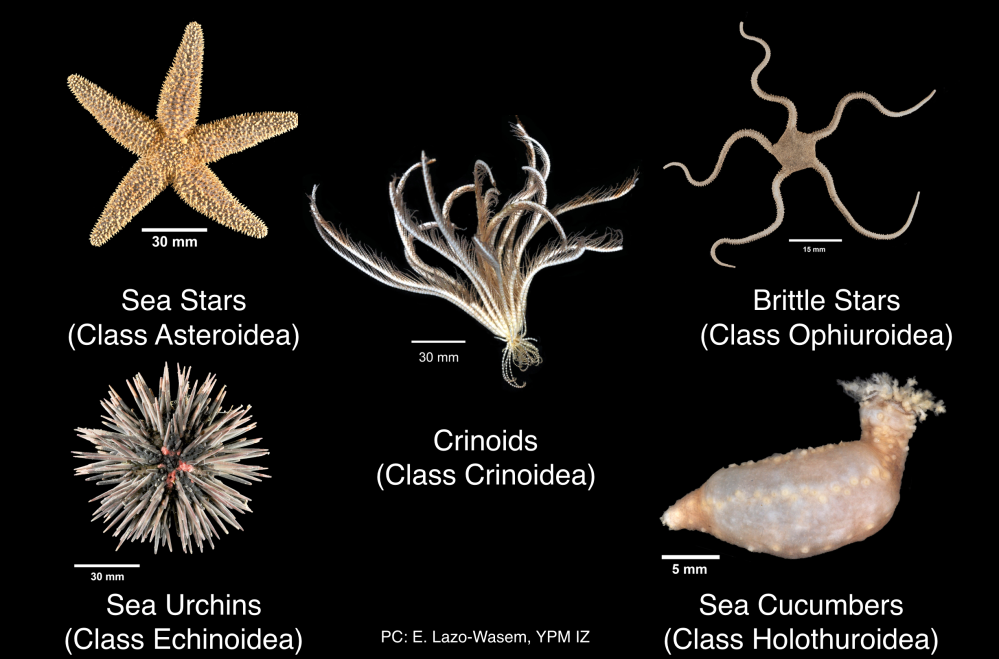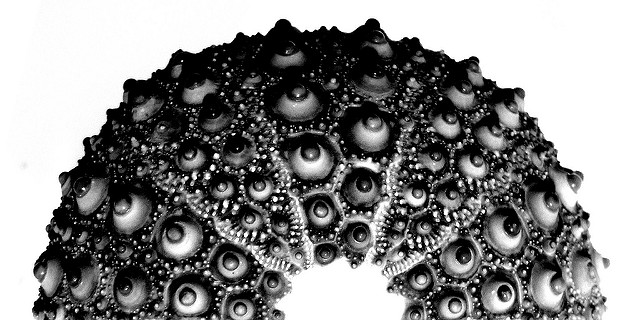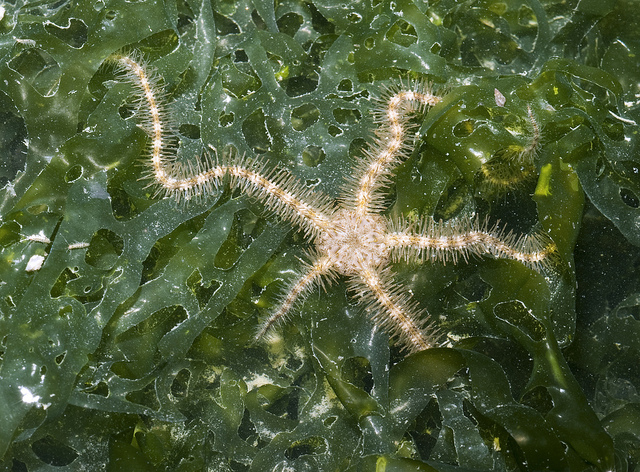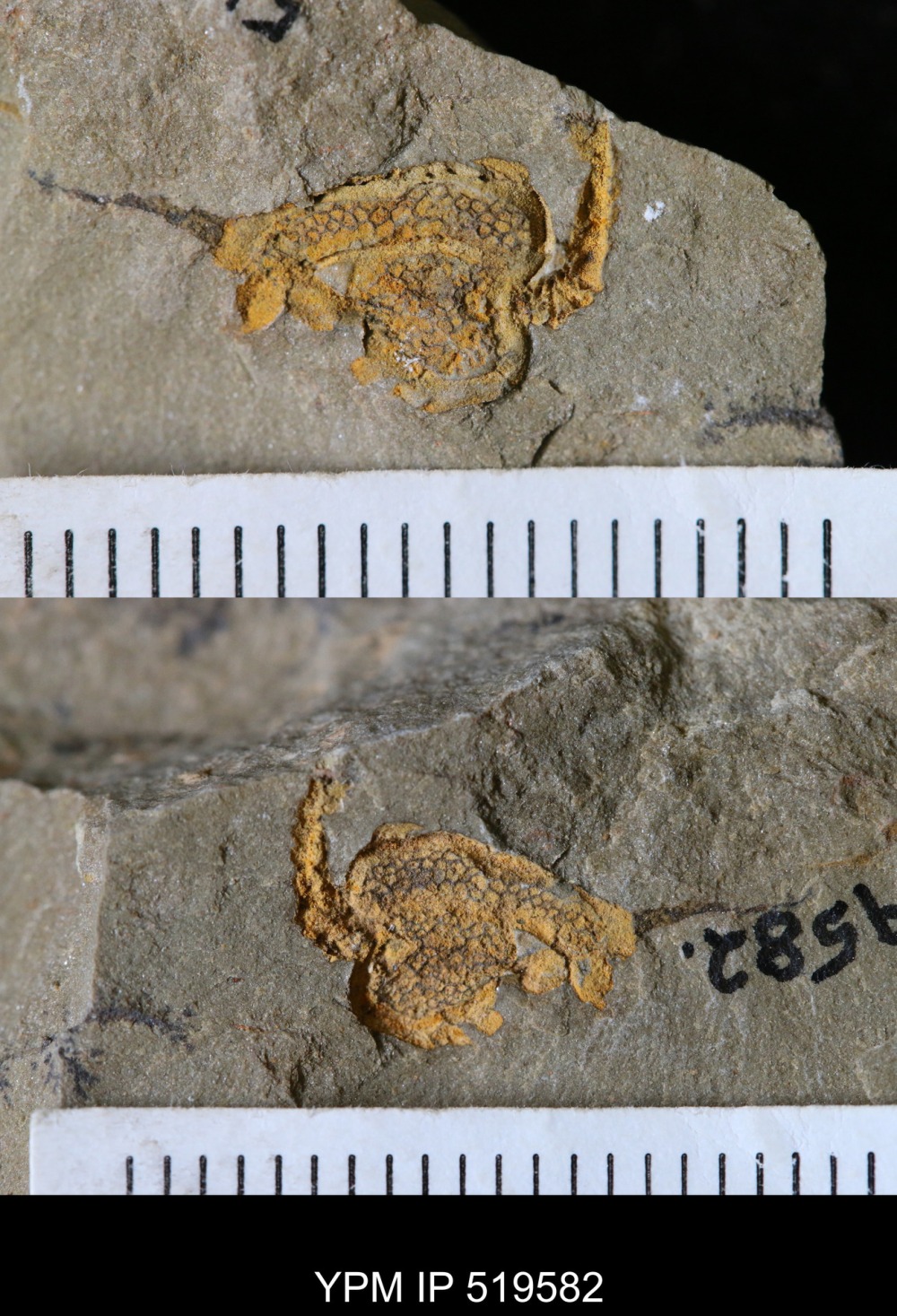This week’s post is from Liz Clark, PhD, a biologist/paleontologist at Yale University (New Haven, USA). If you would like to write for Anatomy to You, get in touch via Facebook or Twitter.
Echinoderms are a group of invertebrates that include sea stars, sea urchins, sand dollars, sea cucumbers, crinoids and brittle stars, and they’re about to become your favorite animals. Here’s what makes them so awesome…

Examples from the five living classes of echinoderms.
- Their internal skeletons inspire architecture!
Even though they’re invertebrates, echinoderms have internal skeletons just like we do. Their skeleton is secreted to make sharp spines, limbs for movement, or tough cases that protect their soft parts– some of which are so sturdy that they’ve been the inspiration for the design of buildings!

A close-up shot of the internal skeleton of a sea urchin. Attribution
- They don’t have brains!
Echinoderms have “decentralized control,” meaning that important things like decision-making aren’t restricted to a centralized structure, like a brain, but are distributed over several parts of the nervous system. Echinoderms can still handle complex processes, like coordinating over 2500 moving parts together for locomotion in some cases, even without a brain1!
- They use a network of hydraulic tubes to move around and pick things up!
All echinoderms have a network of fluid-filled tubes (called the “water vascular system“) that help them do things like manipulate objects, move around, eat, and stick to hard surfaces. The tubes are connected through a network inside the animal, and their external projections are called “tube feet.” Tips of the tube feet in some animals like sea stars even secrete adhesives2!

The tube feet on the underside of a sea star. Attribution
- They can regenerate almost anything!
Skeleton, muscle, nervous tissue, guts, tendons, you name it– echinoderms can regenerate it if they need to. In fact, every regeneration strategy known to occur in animals can be found in echinoderms3!
- They are virtually indestructible!
Not only can echinoderms regenerate their lost parts, they can even shift around the actions of their body parts to stay active while they wait for the missing part to grow back. For instance, brittle stars with missing arms take on new strategies for locomotion so that they can keep moving just as efficiently with fewer arms. Because of this, engineers are using echinoderms as models to design resilient robots4,5.

A brittle star in the process of regenerating a missing arm. Attribution
- They have five-fold symmetry!
Unlike bilateral animals like us, which have one plane of mirror symmetry, echinoderms have five! What’s even crazier is that they evolved from an ancestor that was bilaterally symmetrical. How and why echinoderms evolved five-fold symmetry isn’t known; a subject of ongoing research.
- Their ancestors are insane-looking!
The first fossils of echinoderms are from the Cambrian (541-485 million years ago). These earliest echinoderms look nothing like the ones we have today. Since they’re so strange, a lot of basic aspects about them– even things like where their mouths are— remain a mystery6.

A fossil echinoderm from over 450 million years ago! A member of the enigmatic extinct group of echinoderms called the stylophorans. Attribution: Yale Peabody Museum, photo by J. Utrup.
- Their tendons and ligaments can stretch like rubber bands or melt like silly putty
Imagine being able to keep your arms in the air or hold something heavy indefinitely without getting tired. Echinoderms can! Our connective tissues, like our tendons and ligaments, have a consistent level of stretchiness. These tissues in echinoderms, on the other hand, are made of a specialized material called mutable collagenous tissue (MCT) that can change how stretchy or stiff it is. This lets echinoderms do some amazing things: for instance, crinoids and brittle stars can stiffen or “lock” their tendons and ligaments so that they can hold the position indefinitely without expending any energy. They also use their MCT for a process called “autotomy,” in which they expel their own body parts to distract predators7.
- They are really closely related to us!
Even with all of these amazing features that set them apart, echinoderms are the major group of invertebrates most closely related to us, the vertebrates.

Bring a crinoid to your next family reunion! Attribution
So now you love echinoderms, right?
Learn more: (podcast episode featuring author Liz Clark)
http://www.pasttime.org/podcast/episode-23-meet-the-echinoderms-adventures-in-ancient-sea-stars/
References:
- Watanabe, W., Kano, T., Suzuki, S., and Ishiguro, A. 2012. A decentralized control scheme for orchestrating versatile arm movements in ophiuroid omnidirectional locomotion. Journal of the Royal Society Interface 9: 102-109.
- Santos, R., Gorb, S., Jamar, V., Flammang, P. 2005. Adhesion of echinoderm tube feet to rough surfaces. Journal of Experimental Biology 208: 2555-2567.
- Dupont, S., and Thorndyke, M. 2007. Bridging the regeneration gap: insights from echinoderm models. Nature Reviews Genetics, 8.
- Kano, T., Suzuki, S., Watanabe, W., and Ishiguro, A. 2012. Ophiuroid robot that self-organizes periodic and non-periodic arm movements. Bioinspiration and Biomimetics 7: 1-8.
- Kano, T., Sato, E., Ono, T., Aonuma, H., Matsuzaka, Y., and Ishiguro, A. 2017. A brittle star-like robot capable of immediately adapting to unexpected physical damage. Royal Society Open Science 4: 1-14.
- Zamora, S. et al 2013. Cambrian echinoderm diversity and palaeobiogeography. In: Harper, D. A. T. & Servais, T. (eds.), Early Palaeozoic Biogeography and Palaeogeography. Geological Society, London, Memoirs, 38: 157-171.
- Wilkie, I. C. 2005. Mutable collagenous tissue: overview and biotechnological perspective. In V. Matranga (Eds.),. Progress in Molecular and Subcellular Biology (Marine Molecular Biotechnology), Echinodermata (pp. 221-250). Berlin: Springer-Verlag.
Well, I don’t see myself ever forsaking sauropods. But you’ve made a solid case here, and I’m prepared to call echinoderms my second favourite animals.
Near the start, you listed six groups, then included an illustration captioned “Examples from the five living classes of echinoderms”. What happened to the sand dollars?
LikeLiked by 1 person
They sold out!
LikeLike